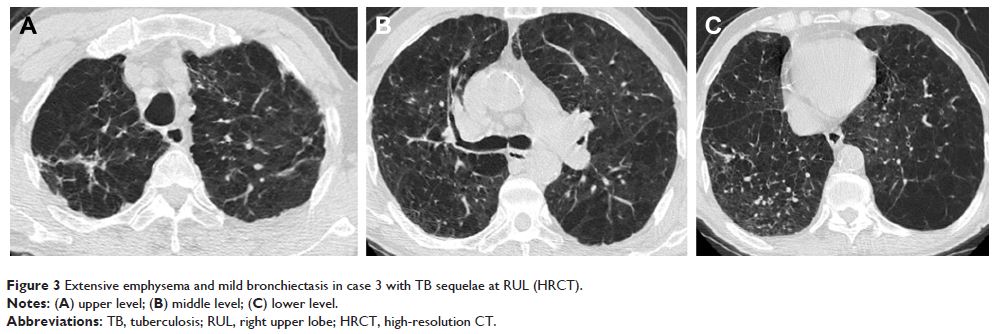108985
论文已发表
注册即可获取德孚的最新动态
IF 收录期刊
- 3.4 Breast Cancer (Dove Med Press)
- 3.2 Clin Epidemiol
- 2.6 Cancer Manag Res
- 2.9 Infect Drug Resist
- 3.7 Clin Interv Aging
- 5.1 Drug Des Dev Ther
- 3.1 Int J Chronic Obstr
- 6.6 Int J Nanomed
- 2.6 Int J Women's Health
- 2.9 Neuropsych Dis Treat
- 2.8 OncoTargets Ther
- 2.0 Patient Prefer Adher
- 2.2 Ther Clin Risk Manag
- 2.5 J Pain Res
- 3.0 Diabet Metab Synd Ob
- 3.2 Psychol Res Behav Ma
- 3.4 Nat Sci Sleep
- 1.8 Pharmgenomics Pers Med
- 2.0 Risk Manag Healthc Policy
- 4.1 J Inflamm Res
- 2.0 Int J Gen Med
- 3.4 J Hepatocell Carcinoma
- 3.0 J Asthma Allergy
- 2.2 Clin Cosmet Investig Dermatol
- 2.4 J Multidiscip Healthc

先天性肺结核 COPD 患者的肺气肿和支气管扩张:计算机断层扫描特征和临床意义
Authors Jin J, Li S, Yu W, Liu XF, Sun Y
Received 24 September 2017
Accepted for publication 7 December 2017
Published 24 January 2018 Volume 2018:13 Pages 375—384
DOI https://doi.org/10.2147/COPD.S152447
Checked for plagiarism Yes
Review by Single-blind
Peer reviewers approved by Dr Charles Downs
Peer reviewer comments 3
Editor who approved publication: Prof. Dr. Chunxue Bai
Background: Pulmonary tuberculosis (PTB) is a risk factor for COPD, but the
clinical characteristics and the chest imaging features (emphysema and
bronchiectasis) of COPD with previous PTB have not been studied well.
Methods: The presence, distribution, and severity of emphysema and
bronchiectasis in COPD patients with and without previous PTB were evaluated by
high-resolution computed tomography (HRCT) and compared. Demographic data,
respiratory symptoms, lung function, and sputum culture of Pseudomonas aeruginosa were
also compared between patients with and without previous PTB.
Results: A total of 231 COPD patients (82.2% ex- or current smokers, 67.5%
male) were consecutively enrolled. Patients with previous PTB (45.0%) had more
severe (p =0.045) and longer history (p =0.008) of dyspnea, more
exacerbations in the previous year (p =0.011), and more
positive culture of P. aeruginosa (p =0.001), compared with those
without PTB. Patients with previous PTB showed a higher prevalence of
bronchiectasis (p <0.001), which was more
significant in lungs with tuberculosis (TB) lesions, and a higher percentage of
more severe bronchiectasis (Bhalla score ≥2, p =0.031),
compared with those without previous PTB. The overall prevalence of emphysema
was not different between patients with and without previous PTB, but in those
with previous PTB, a higher number of subjects with middle (p =0.001) and lower (p =0.019) lobe emphysema, higher
severity score (p =0.028), higher prevalence of
panlobular emphysema (p =0.013), and more
extensive centrilobular emphysema (p =0.039) were
observed. Notably, in patients with TB lesions localized in a single lung, no
difference was found in the occurrence and severity of emphysema between the 2
lungs.
Conclusion: COPD patients with previous PTB had unique features of
bronchiectasis and emphysema on HRCT, which were associated with significant
dyspnea and higher frequency of severe exacerbations. While PTB may have a
local effect on bronchiectasis, its involvement in airspace damage in COPD may
be extensive, probably through interactions with cigarette smoke.
Keywords: chronic obstructive pulmonary disease, tuberculosis, bronchiectasis,
emphysema
